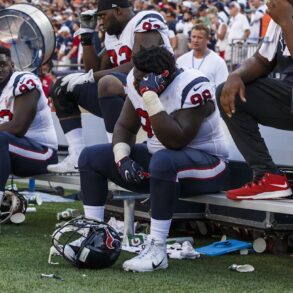Steve Wright, an NFL lineman whose impressive stature was immortalized in a sculpture that became the NFL’s Walter Payton Man of the Year trophy, has died at the age of 82.
The 6-foot-6, 250-pound Wright was a giant for his day and an imposing offensive tackle at Alabama, where he won a national championship in 1961. He was drafted by both the Packers in the NFL and the Jets in the AFL in 1964.
Wright chose to play in Green Bay, and he won three championships and played in Super Bowls I and II. He later bounced around the league in four different cities, playing in New York, Washington, Chicago and St. Louis before finishing his professional career in the World Football League in 1974.
In an era when football players were expected to follow their coaches’ orders, Wright — despite playing for the hard-nosed Bear Bryant in college and Vince Lombardi in the NFL — gained a reputation for questioning everything. At the end of his career he published a memoir, I’d Rather be Wright: Memoirs of an Itinerant Tackle, that gave fans an inside look at life in pro football from an irreverent perspective that had rarely been shared before.
But Wright is best known for serving as a model for sculptor Daniel Bennett Schwartz after the NFL commissioned Schwartz to make a distinctive trophy for a new award the league wanted to bestow on a player who epitomized everything that’s right about the men who play pro football, both on and off the field. Wright stood in his uniform with a giant cape-like overcoat on his shoulder pads as Schwartz went to work creating a statue he called “The Gladiator” that the NFL adopted as its Man of the Year Trophy.
In 1970, Johnny Unitas became the first player to receive that NFL Man of the Year trophy. Walter Payton got the award in 1977, and after he died in 1999 the league changed the award’s name to Walter Payton Man of the Year.
The self-deprecating Wright often joked about how amusing he found it that such great players and great men were presented with “a statue of me.”
Wright was the first to admit he wasn’t a great NFL player, agreeing in his book with Lombardi’s assessment that he had the physical talent to be a bulldozing lineman but was too nice a guy to want to run over the player across the line from him. But Wright will always have a connection to some of the NFL’s all-time greats, thanks to the award that bears his likeness.
This post was originally published on this site be sure to check out more of their content.









